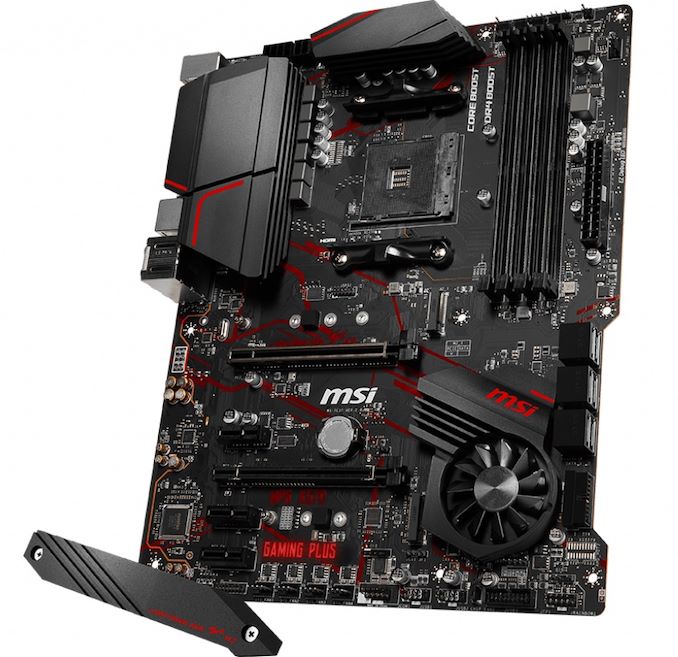The AMD X570 Motherboard Overview: Over 35+ Motherboards Analyzed
by Gavin Bonshor on July 9, 2019 8:00 AM ESTMSI MPG X570 Gaming Plus
The MPG X570 Gaming Plus is MSI's entry-level gaming model and It's equipped with a modest feature set which includes with one PCIe 4.0 x4 M.2 slots, and two-full length PCIe 4.0 slots with support for two-way AMD CrossFire multi-graphics card setups.
Firstly the aesthetic is based on a traditionally recognized red and black theme; this design extends from the heatsinks onto the PCB. The chipset heatsink cooling the X570 chip includes a cooling fan for optimal performance, while the power delivery heatsinks are separated from each other to provide cooling to the CPU VCore. There are 8-pin and 4-pin 12 V ATX CPU power inputs to delivery power to the processor, while the power delivery is running at 8+2 design with an International Rectifier IR35201 PWM controller.
Located in the top right-hand corner of the board are four memory slots which support DDR4-4400, with up to a maximum capacity of up to 128 GB. Moving down the PCB is two full-length PCIe 4.0 slots that operate at x16, and x16/x4, with an additional three PCIe 4.0 x1 slots. There are two PCIe 4.0 x4 M.2 slots, with one of the slots coming with a heatsink; there are also six SATA ports present.
On the rear panel are a single USB 3.1 G2 Type-A, one USB 3.1 G2 Type-C, four USB 3.1 G1 Type-A, and two USB 2.0 ports. A single HDMI video output gives the capability to use an AMD Ryzen APU, while a Flash BIOS button and a PS/2 combo port are also featured. Even MSI's entry-level gaming option includes the premium Realtek ALC1220 HD audio codec which provides five 3.5 mm audio jacks and S/PDIF optical output, while a Realtek RTL8111H Gigabit NIC controls the single Ethernet port.
The MSI MPG X570 Gaming Plus is the entry-level model to the X570 chipset from its product stack which also has a clear gaming look about it. With a red and black design, it's a throwback to MSI of more recent times, but the board has no integrated RGB which users may find slightly disappointing. The power delivery although adequate, probably isn't the best around for overclocking aRyzen 3000 processor to its limits, but with an MSRP of $169, it's horses for courses.












225 Comments
View All Comments
abufrejoval - Tuesday, July 9, 2019 - link
It's amazing how quickly you run out of PCIe lanes, when you don't have switches to multiplex and translate between PCIe revisions and lanes (e.g. PCIe v4 x2 <-> PCIe v2 x8).I find myself using USB 3.x NBase-T NICs and NVMe adapters, simply because they *do* switch.
Bensam123 - Tuesday, July 9, 2019 - link
Maybe a bit more depth on the power delivery page. I have absolutely no idea how to go about parsing what's there. More chokes is better? What denotes a power phase?A5 - Tuesday, July 9, 2019 - link
+1. Some analysis of that information would be helpful.MrSpadge - Tuesday, July 9, 2019 - link
+1bunkle - Wednesday, July 10, 2019 - link
The controller column includes the total number of phases supported split between CPU cores and SoC e.g. (6+1) = 6 CPU phase and 1 SoC phase. More is *usually* better but has diminishing returns regarding tighter and tighter voltage regulation. Some controllers are better than others (can operate at high frequency e.g. 500KHz v 1000KHz, include other features to improve performance) mitigating the need for more phases.Each phase is a buck converter comprised of a low/high side MOSFET (can be integrated in a single package) and choke. Some controllers can support doubling up the PWM signal to driver more MOSFETs. Doublers can also be added as discrete components if not built into the controller.
Current rating of the MOSFET (e.g. Sic639=40A IR3555=60A) indicates the total power deliverable. MOSFETs are not 100% efficient and vary in efficiency. The more current they provide the hotter they get and the less efficient they become, with better MOSFETs producing less heat for a given current. Thus using doubles can improve temperatures and efficiency without the benefits of the tighter voltage tolerance that *real* phases provide.
Hope that’s helpful!
bunkle - Wednesday, July 10, 2019 - link
A lot more detailed explanation: https://en.wikichip.org/wiki/voltage_regulator_mod...bug77 - Tuesday, July 9, 2019 - link
The description for AsRock X570(M) Pro4 says "5 jack + 1 SPDIF". Unfortunately, those boards lack SPDIF and only come with 3 jacks ;)Smell This - Tuesday, July 9, 2019 - link
I'm thinking the *ASRock Thunderbolt AIC* ...https://thunderbolttechnology.net/product/asrock-t...
would cover all your TBT peripheral needs, including optical.
DanNeely - Tuesday, July 9, 2019 - link
Do X570 boards still need an extra chip per USB port to support USB-C reversibility?The additional expense and needed PCB space were cited as among the reasons why earlier generation boards (IIRC both Intel and AMD) almost never had more than 1 C port; but it was never clear to me if that was an inherent implementation penalty for the C port or an artifact of Intel's tech stack being stalled out and AMD outsourcing to ASMedia which built the chipsets on an ancient (55nm) platform.
DigitalFreak - Tuesday, July 9, 2019 - link
Gavin - X370 and X470 only supported PCIe 2.0. The connection between the CPU and chipset was 3.0, but all the ports on the chipset were 2.0.